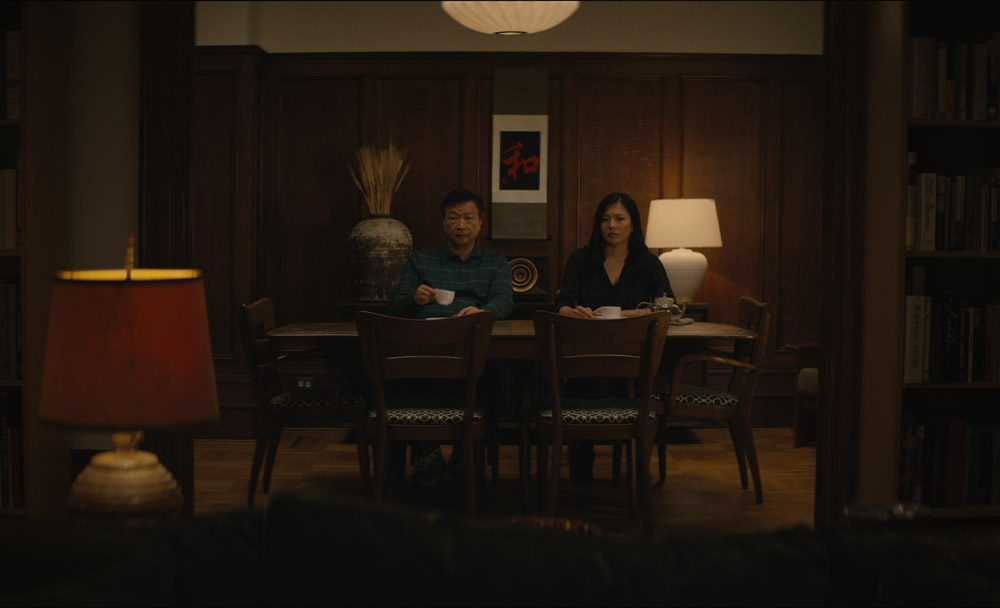Shortly after “Tigertail” premiered on Netflix this past weekend, Amy Williams was busy keeping tabs on her social media feeds.
“A lot of people have been posting pictures of their parents and their grandparents, which I was so hungry for as references when we were making the film,” says the production designer. “All I wanted to do was see Taiwanese grandmas and grandpas at their houses, so now to see all these people responding personally with these family photos, it’s just the coolest thing ever.”
Even if the occasion of the film’s premiere hadn’t prompted this outpouring, it’s likely that Williams would’ve been just as eager to seek out this window into other people’s lives, so often being the one to open them up in her work. Originally studying art and managing a gallery before getting pursuing a career in show business, her eye for curation hasn’t been wasted in populating the spaces that the characters in her films inhabit with personal artifacts full of small, splendid details that bring the personal histories vividly to the surface, and as a veteran of New York-set productions such as Ira Sachs’ “Love is Strange” and Leslye Headland’s “Sleeping with Other People,” it can often feel as if any humble apartment door in the city can open up to a different world if she’s behind the scenes.
This versatility and attentiveness made Williams an ideal collaborator in Alan Yang, whose series “Master of None,” “Forever” and “Little America” have felt so fresh in part because of reflecting the multicultural reality of contemporary American life, and for his feature debut “Tigertail,” the writer/director turned to her once more for a story of epic scope told on an intimate scale, relating the journey of Pin-Jui (Tzi Ma), a Taiwanese immigrant who puts aside his personal happiness in pursuit of a more stable future in America, a sacrifice that his daughter Angela (Christine Ko) couldn’t know much about when he has trouble talking to her about anything, let alone the past. While the film spans across generations and continents, Williams’ work can distill the weight of time and distance into each individual frame, with Pin-Jui’s home physically reflecting the life he’s built in the U.S. with family pictures and various knickknacks but allowing the empty space carry the weight of what he had to leave behind, and flashbacks to Taiwan drawing on the inspiration of being actual places that Yang’s real-life family once called home to create locales that activate the senses like sharp pangs of memory.
Williams was kind enough to speak about her work on “Tigertail,” as well as her ongoing collaboration with Yang and a creative team that has now come together on several productions, and the exciting opportunity to engage with a new set of collaborators in Taiwan to bring her latest film to life.
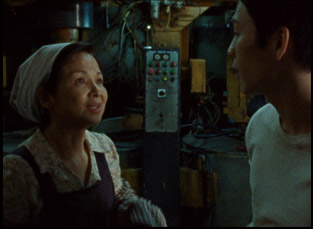
I interviewed for “Master of None,” when it was called the “Untitled Aziz Ansari Project” and I sat down with Aziz and Alan and we talked about my experience in New York. They had a lot of interesting takes on how they wanted their comedy show to look. They referenced a lot of ‘70s films and a lot of cinematic references and it was the first time I talked with someone about comedy looking cool, so I was really sold. Alan and I connected on many levels. We’re film nerds, but we’re also basketball weirdoes and so it was an instant creative and friendship opportunity and from there, he’s kept me employed. [laughs] We worked on an Amazon series called “Forever” and also a series called “Little America” on Apple and for him [“Tigertail”] was one of his passion projects and his first feature, so I was honored to join him for that.
Is it a different discussion with him when the project is as personal as “Tigertail”?
This certainly was the most intimate of collaborations because he’s lived this, he wrote this, and it’s loosely based on his family. He was able to show me photos of his grandmother living in Taiwan, so the collaboration is both trying to bring his story to fruition, but also make it cinematic and make it interesting and make it relatable for an audience and give them an understanding of the feeling we’re trying to convey.
You’ve said for “Little America,” you were interviewing the real-life subjects whose stories inspired episodes in the series. Was it a similar situation here?
I like to engage actors generally, but we’re working with real people and real stories and that just makes the experience even more rich. You research these real people and dig up any press, any photos, any materials you can find out about them, their culture, where they’re from and their time period, and if you’re lucky enough, you actually get to engage with them and have a discussion. With “Little America,” I would ask them what their living rooms look like or what they have on their nightstand, just to get those little details right because it’s such a different cultural perspective and that will help people relate to the story, so it’s a great aspect of designing.
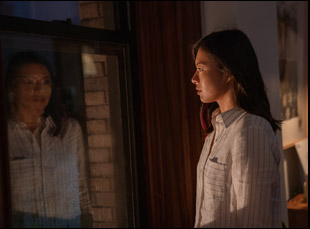
It was amazing. We shot at the sugar factory that Alan’s grandmother worked in, so you could feel the weight of history and the presence of past and coming from the U.S., having never been to Taiwan, as a designer, you come with an open heart, open mind and things pop out that lend to the design, which I think [you have] to be [in order to be] successful. [You need] flexibility to fully understand not just the logistics of whose job it is to get the props and paint the walls, but also a cultural understanding of how high do we hang these portraits on the wall? What’s typical? There’s a lot of time that the design is dictated by that personal time you spend with [the local crew], eating meals and drawing things and finding commonalities and getting excited over similar references and color palettes.
There’s a certain color palette that Taiwan has of the greens and reds and scouting and seeing these locations really is what informs the design of the show. It doesn’t really come together until you’re in these spaces with the DP Nigel [Bluck] and with Alan and it’s so intense. We went to the mausoleum where his grandmother is buried and there’s a shot in the montage at the end [that] we actually chose the location where his grandmother’s remains are [for] and we put our actors’ photos over it, so it’s deeply personal and moving and real.
Throughout the film, the colors really can tell the story of the environments as much as the items in them. What was it like figuring out those contrasts?
We had different sections in the film. You have the flashbacks to Taiwan, you have the flashbacks to post-immigration experience in the Bronx, so we wanted to give both those worlds different palettes. We did a lot of reds and greens in Taiwan and once they moved to the U.S., there’s a lot of blues and mustards and then you move into present day and that’s where we desaturated everything and Alan and Nigel chose to shoot on digital for those moments where they chose to shoot on Super 16 for the flashbacks. In terms of the design, we really bleached out a lot of the color that you saw at the beginning that was so vibrant, so full of life when [Pin-Jui] was younger and he’s having memories of his past and not that the current day is depressing – well, right now it is [laughs] — but we definitely looked at several past cinema references and I looked to a lot of photography for color and composition. We had Greg Girard, Harry Guyart, and Helen Levitt photographs up on our wall and there’s a book called “The Lams of Ludlow Street” from Photographer Thomas Holton that has some amazing photography from Chinatown, so it was from there that we developed a palette and took risks going more colorful and [have] more contrast.
Were you thinking of the sets relative to one another to express all the dichotomies of the characters? I’m thinking of the scenes where Grover and Angela eat in their respective homes and the shot is the same.
Yeah, they all interconnect and you have this family throughline. In so many ways, Angela is like her father and vice versa. Their mistakes and their hopes and their dreams are similar and the way that they deal with things emotionally, so from set to set, you want to bring elements that tie that history together. They’re very subtle, but there are easter eggs that you can see in [Pin-Jui]’s Bronx apartment that ends up in his final apartment and photographs of family that you see in both of their apartments that are duplicated. Angela represents the modern first-generation Taiwanese American and [Pin-Jui] represents the past and the sacrifice, so you have those contrasts of leaving your history behind, but [also] what you hold onto.
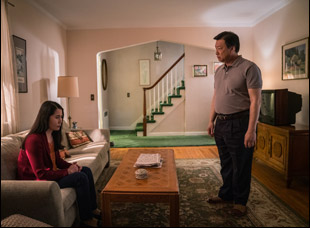
Yeah, the actors think so much about their characters and part of my job is to supply the actors spaces in which they can feel their characters and they can move around and provide interesting ways to occupy the space, so it’s really great to engage with really thoughtful actors. You talk in terms of character as opposed to personal taste, [like] what kind of colors does Angela like? What kind of artwork would she have on her wall? And in the case of Christine Ko, she gave us a lot of photographs of her and her father that we placed throughout the apartment. That really helped her emotionally relate to the piece and relate to the performance because there were pieces of her and her past and her emotions within the set to create this character.
Was there a favorite detail of yours to incorporate into the design of this?
My favorite set would be [Pin-Jui]’s Bronx apartment that he first moves into. That was a real location that we found and by all accounts, we should not have been shooting there. It was very small, not production friendly at all, but it had the history and a certain ominous feel about it. When we walked in, it was a bright white space and it was occupied by a Puerto Rican family, but we were able to take over their space for a few weeks and really layered it with a lot of age and paint and color. For me, that was the most successful set because there’s a simplicity about it, and coupled with the neon red light outside of the window, I thought it created a really great sense of isolation and transition.
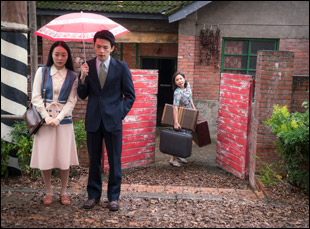
Yeah, it really does. The great thing coming from a scouting and location background is that it’s so much a part of the work, especially these days when you are both building sets and augmenting locations to look like the real thing. Just from a logistical standpoint, I have an understanding of how to work with locations managers and how to communicate my ideas about what I think a space should look like or how a house should be or what an environment should be because they’re the ones that need to search out and find these things. Without any direction or without a similar language, it can be a difficult task, but luckily, I have this background in other departments and you gain a shorthand, which is really helpful.
What was it like to see this all come together in “Tigertail”?
It was really emotional. It became such a personal story, and a lot of our “Master of None” family – Alan, the editor, the music supervisor, became very close because we’ve worked on four or five projects together at this point, so you have your film family and then you have the narrative family that you deep dive into. You also have Alan’s past that you get to know so well and his family members that you speak to and connect with, and then filming in Taiwan, you have a crew suddenly working for you that speaks a different language and that, for me, was the most rewarding of experiences because we all are filmmakers, but you need to be able to lean on your crew in a different country to help explain how things look and how they should be and the way you want to convey things, and it was a really special relationship working with my Taiwanese crew.
“Tigertail” is now streaming on Netflix.




